
Underfloor Heating Tiles
Luxury warm tiled floors can be achieved easily with BN Thermic’s M-series underfloor matting. Below walks you through the matting along with the energy saving impact of insulation boards and thermostat control.
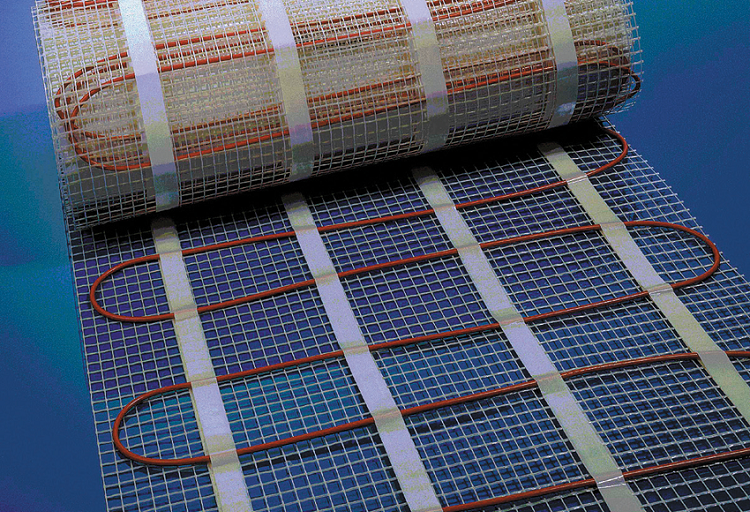
M Series underfloor heating mats are backed with a lifetime warranty
Underfloor Heating Tiles
Underfloor heating in a room with a tiled floor can provide an economical means of heating a room whilst also providing a luxurious warm floor. The heating equipment to meet both these objectives is usually the same although there may be a difference in the way the thermostat is set up and we will look at that in the control section below.
Both heating systems supplied by BN Thermic use a high-quality heating cable and both should be installed immediately below the tiles either in the tile adhesive or in a latex-based self-levelling compound.
Heating Mats
The most widely used method of underfloor heating for a tiled floor is the heating mat. BN Thermic heating mats consist of a twin-core heating cable assembled onto a 500mm wide fibreglass web. The cable is pre-terminated with a 3m power lead and the web is fitted with a continuous run of double-sided tape.
Heating mats can be installed in any room including bathrooms and wet rooms.
Heating mats are best suited to more regular-shaped rooms. The 500mm wide fibreglass web maintains optimum cable spacing and ensures the quickest possible installation time.
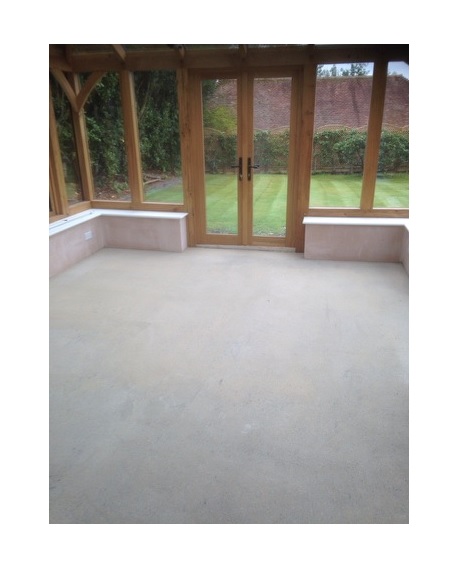
A concrete subfloor
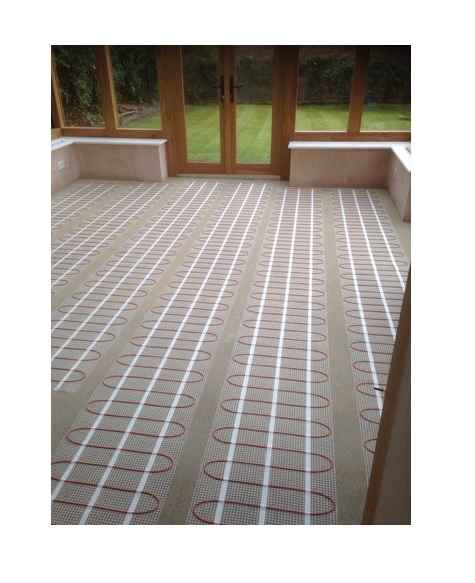
M series mats installed ready for latex
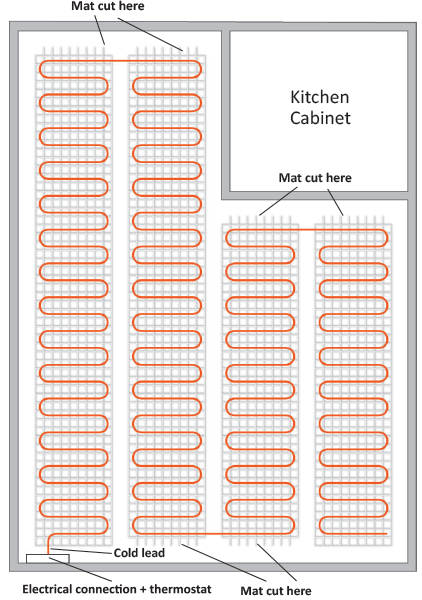
BN Thermic can assist selecting the right mat your underfloor heating project
Selecting a Suitable Mat
BN Thermic offers two ranges of heating mats: standard output (150W/m²) and high output (200W/m²). High-output mats are generally used in high heat loss rooms such as conservatories or when the fastest possible warm-up time is required. For most rooms, standard output mats are sufficient.
When selecting mats for a specific room, the objective is to cover as much of the free floor area as possible. Mats should not be installed under fixtures such as kitchen cabinets and shower trays. As a rule of thumb, we suggest selecting a mat with an area approximately 10% smaller than the free floor area.
BN Thermic supplies mats covering areas up to 18m². However, for larger rooms, it is common practice for two or more mats to be used. Generally, the mats are connected in parallel and controlled by a single thermostat.
Heating Cables
Heating cables are recommended for smaller and irregularly shaped rooms. The cable or ‘loose wire’ as it is sometimes called, is supplied on a drum and is pre-terminated with a 3m power lead. Each cable is supplied with sufficient high adhesive tape to hold the cable to the subfloor.
BN Thermic heating cables can be installed in any room including bathrooms and wet rooms.
The cable should be arranged in a series of evenly spaced loops covering as much of the free floor area as possible.
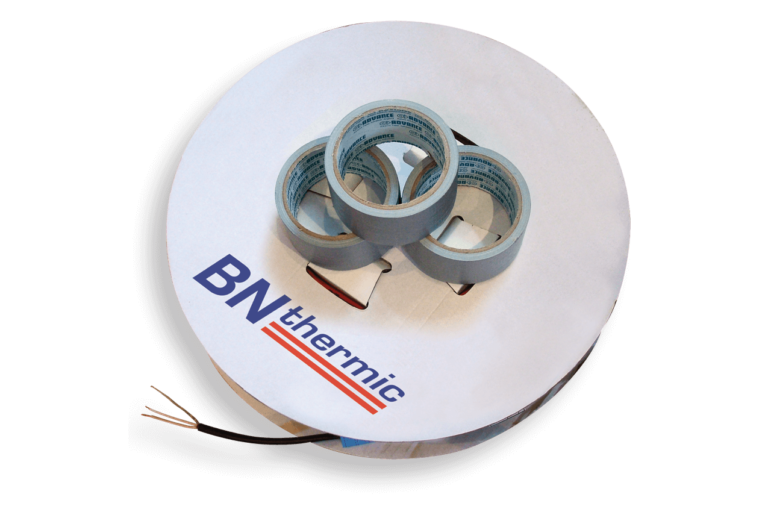
BN Thermic loose cable systems are covered with a lifetime warranty
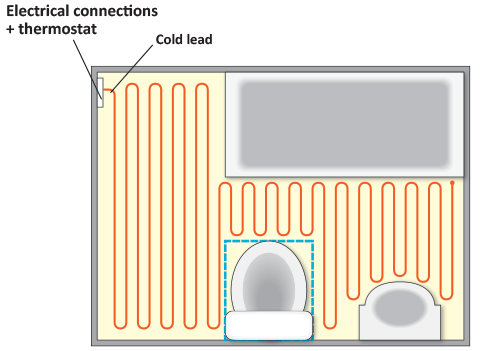
Loose cable systems are ideal for irregularly shaped rooms
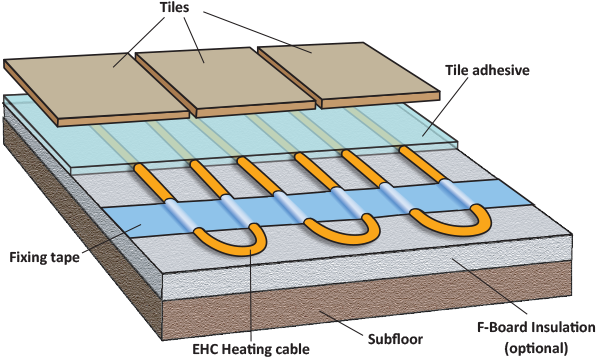
A cross section of a loose cable installation
Selecting a Heating Cable
First, calculate the free floor area (total floor area minus any permanent fixtures such as cabinets and shower trays). Then, simply select the cable with a coverage range which includes the calculated free floor area.
For larger rooms, it is common practice for two or more cables to be used. Generally, the cables are connected in parallel and controlled by a single thermostat.
The Importance of Insulation
The best way to reduce the running costs of an underfloor heating installation is to limit downward heat loss using insulation. Many modern homes have well-insulated floors. However, in older properties, insulation should be installed before a mat or cable is fitted.
BN Thermic supplies two thicknesses of insulation boards 6mm and 10 mm. Whenever possible, we would suggest installing the 10mm thick boards which are simply stuck to the sub-floor using tile adhesive.
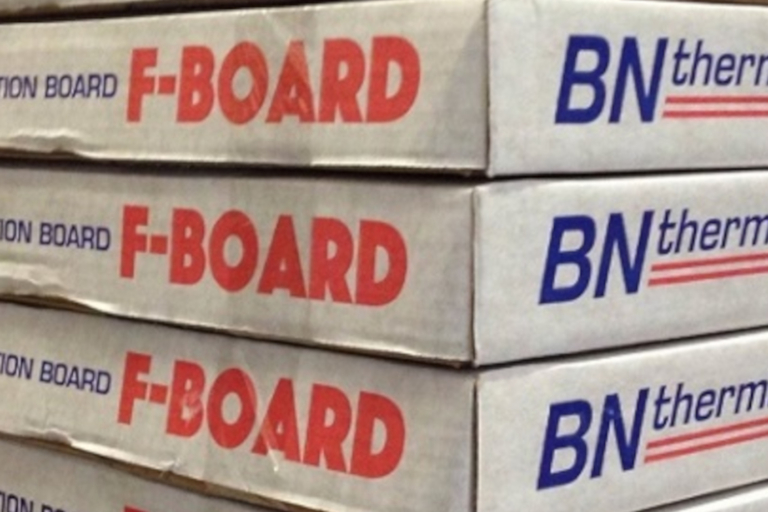
Insulation boards greatly improve the economy of an underfloor heating system. BN Thermic always carry large stocks
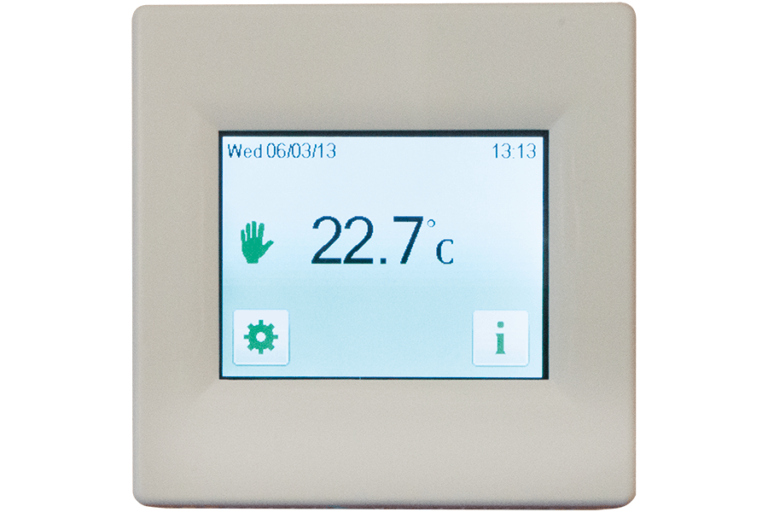
The T16C color touch screen range of controllers is available in three finishes – white, silver and black
Thermostatic Control
Each room will require a programmable thermostat. BN Thermic offer a range of suitable thermostats to meet different aesthetic requirements, tastes and budgets. However, all BN Thermic programmable thermostats share the same key features.
When using underfloor heating as a sole source of heat, primary temperature control is using the thermostat’s built-in temperature sensor. The thermostat’s floor probe, which is installed at the same level as the heating mat or cable, will then act as a safeguard ensuring that the floor does not become uncomfortably warm.
If the main aim of the system is to provide a warm floor, especially when other methods of heating are in use, the thermostat’s built-in air sensor should be passed and temperature control should only be using the floor probe. The adjustment from ‘air and floor’ to ‘floor only’ is simple to achieve and detailed instructions are provided with the thermostat.
In some installations, notably bathrooms, it is common for the thermostat to be located outside the room being heated. In these circumstances ‘floor only’ control is generally used.
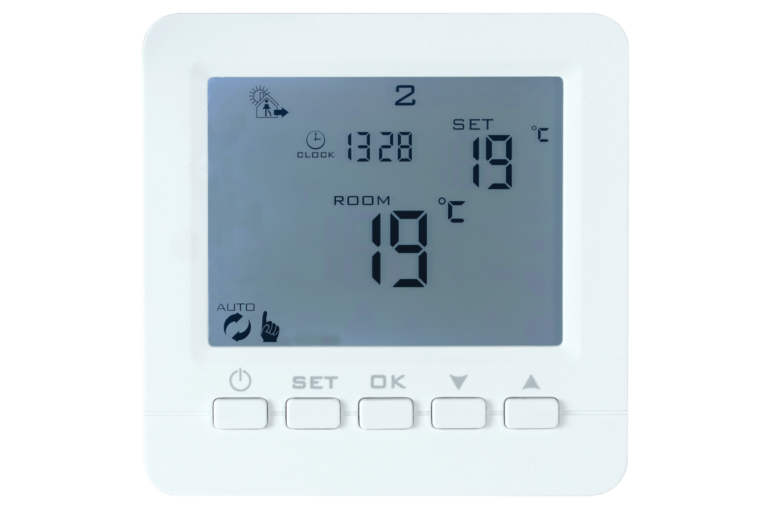
The new B16C controller offers full 7 day control at a very competitive price
Underfloor Heating Tiles FAQs
-
How warm should underfloor heating feel?
-
A tiled floor with underfloor heating will not feel anything as hot as a conventional radiator. This is because the required heating effect is spread over the entire floor area. We generally suggest a thermostat’s floor probe is used to limit floor temperatures to around 28°C maximum and, depending on where we are on the heating cycle, the floor will often be somewhat cooler than that.
-
How reliable is underfloor heating and how long does it last?
-
A good quality electric underfloor heating cable mat such as BN Thermic’s M Series is very reliable and, assuming correct installation will last indefinitely. We are so confident in this product that we offer a lifetime warranty.
Should there be a need to replace or update your thermostat at any time, this can be done without making any changes to the heating mats or the floor.
-
Can you retrofit underfloor heating?
-
Yes, anytime you are replacing a tiled floor it is easy and inexpensive to incorporate an electric underfloor heating mat such as BN Thermic’s M Series.
-
Can underfloor heating crack tiles?
-
No, underfloor heating cable mats such as BN Thermic’s M series cannot crack tiles assuming they are installed according to the instructions provided.
-
Can you have underfloor heating with wooden floors?
-
For wooden floors, rather than using cable mats such as BN Thermic’s M Series, we generally recommend a foil mat system such as BN Thermic’s F Series which is designed for installation directly under laminate or engineered wood floors.
-
Can I use underfloor heating as the only heating in a room?
-
Standard M Series heating mats deliver 150W per square metre. In most rooms, this will be sufficient to provide a sole source of heat. In rooms with high heat loss, such as some conservatories, we suggest using a higher output 200W/m² mat and very occasionally supplementary heating may be required.
-
How do I install electric underfloor heating mat?
-
Underfloor heating cable mats and loose cables must be completely covered by a latex-based self-levelling compound or suitable tile adhesive before the tiles are fitted. We strongly recommend rigid insulation boards such as BN Thermic’s F-Board are used to limit downward heat loss. Here is a link to detailed cable mat installation instructions.
-
How many insulation boards to I need for a foil underfloor heating installation?
-
We recommend that cable mats such as BN Thermic’s M Series are installed onto suitable rigid insulation boards which limit downward heat loss and improve economy.
BN Thermic’s F-Board is ideal for this purpose. Each board covers 0.72m² and can be easily cut to the size and shape required. To calculate the number of F-Boards required, simply calculate the total floor area in m² and divide the answer by 0.72. So, for example, if the total room area is 8.9m² you should divide this number by 0.72 to get 12.36 meaning that you would need a minimum of 13 F-Boards. Of course, you may like to order one extra board to make allowances for any inaccuracies in area estimation or installation.
Electric heating can provide a dramatic reduction in running costs. Pew heaters or infrared quartz halogen heaters heat people directly keeping the warm-up time to an absolute minimum.
-
How much does underfloor heating cost to run?
-
If we assume an electric tariff of 13p/kW/h, standard M Series heating mats will cost 1.95p to run for each heated square metre on full power. This simple figure will allow you to calculate the absolute maximum running costs for your room depending on the size of the room and the hours per day you wish to heat the room.
Once the underfloor heating has produced the required room temperature, its output will be regulated by a thermostat. At this stage, the running cost per metre will be greatly reduced.
Now, there are a few simple things that you can do to reduce this cost.
- Insulate the floor before installing the heating
- Keep windows and doors shut
- Use a good quality thermostat and investigate energy-saving features such as ‘optimum start’ and ‘open window detection’.
- Make sure that your thermostat is set to the lowest acceptable temperature and is programmed to be on for the shortest acceptable time.
These ideas may sound obvious, but they really will make a big difference!
-
Can the heating cable be shortened or extended?
-
Underfloor heating mats consist of a heating cable which attached to a glass-fibre webbing. The heating cable runs, in evenly spaced loops, the entire length of the mat. This cable must not be cut or shortened. The mat itself can be cut to allow the heating to be manipulated to suit the shape of the room. Each M Series mat is fitted with a 3m power cable which connects the mat to the thermostat. This power cable can be shortened or extended to suit.
-
Can furniture or rugs be placed on a heated tile floor?
-
Electric Underfloor heating mats should not be positioned under solid, permanent or floor-fixed furniture as these items can trap heat and cause localised overheating.
For the same reason, thick rugs, bean bags, dog beds and other items with high insulation values should be avoided.
-
Can underfloor heating be used with carpet?
-
M Series cable mats can be used with carpets. The mats must be covered in a covered in latex-based self-levelling compound and the lowest tog underlay/carpet combination should be selected. If you have any doubt about the suitability of a particular carpet or underlay, please consult the supplier.